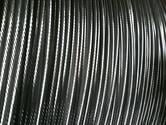-or-
“I asked for stainless steel aircraft cable, but this cable is magnetic.”
magnetic.”
And it just may be both. In fact, they are not mutually exclusive: stainless steel is not totally non-magnetic.
Here’s an in depth explanation from our Engineers in the LoosCo.com FAQ Department:
Magnetic permeability is the ability of a material to carry magnetism, indicated by the degree to which it is attracted to a magnet. All stainless steels, with the exception of the austenitic group, are strongly attracted to a magnet.
And for Specific Material Grades:
 All austenitic grades have very low magnetic permeability’s and hence show almost no response to a magnet when in the annealed condition; the situation is, however, far less clear when these steels have been cold worked by wire drawing, rolling or even center-less grinding, shot blasting or heavy polishing. After substantial cold working, Grade 304 may exhibit quite strong response to a magnet. Grades 310 and 316 will in most instances still be almost totally non-responsive.
All austenitic grades have very low magnetic permeability’s and hence show almost no response to a magnet when in the annealed condition; the situation is, however, far less clear when these steels have been cold worked by wire drawing, rolling or even center-less grinding, shot blasting or heavy polishing. After substantial cold working, Grade 304 may exhibit quite strong response to a magnet. Grades 310 and 316 will in most instances still be almost totally non-responsive.
As for "non-magnetic" specifications: Our SS305 cables are designed to meet the mechanical performance criteria of specification MIL-DTL-18375, the federal specification for non-magnetic cable. However, they are not completely nonmagnetic. All 300 series stainless steel materials will work harden and increase magnetism with normal bending (cold working) such as that of typical cable application. It is inherent in the material. Naturally the 305 is less susceptible to this, but it is more of a metallurgical question than a cable one.
So put down the magnet. Work hardening (as seen in the cable manufacturing process) and typical usage of cable creates magnetism. The product certificate supplied with your order will provide the chemical properties of the material we used, and that’s a much more accurate indicator than your magnet will ever be!
Call a Loos & Co., Inc sales representative or product manager if you have any questions about the material you are receiving or its magnetic properties. If you need a completely non-magnetic matreial, we offer many exotic alloys, including phos-bronze. We would be more than happy to discuss solutions with you.



